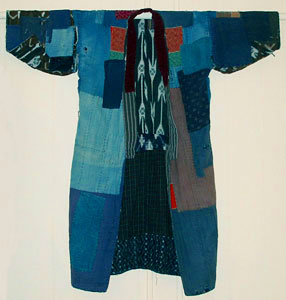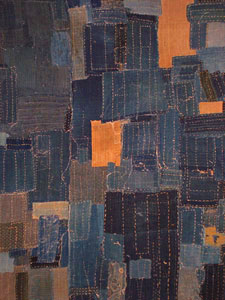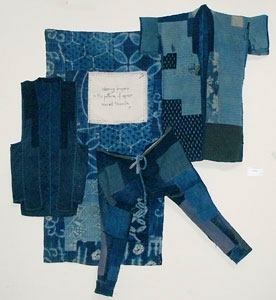Gualala Arts
Lecture Series presents:
Riches from Rags:
Japanese Country Textiles
with DeAnn Tyler
Monday, May 4, 2009, 7:00 p.m.
Admission is $5
Gualala Arts will present a lecture "Riches from Rags: Japanese Country Textiles" with DeAnn Tyler
on Monday, May 4 at 7:00 p.
 This lecture will bring new insights to every textile lover and quilt maker, many of whom may already have experienced the graphic appeal of African American work clothes quilts in the recent Gee's Bend exhibit. Like the Gee's Bend work, the Japanese tradition uses layer upon layer of patched fabric and creates a geometric simplicity reminiscent of Amish quilts and modern art. Also like the African American improvisational quilts, Japanese country textiles were created out of necessity.
This lecture will bring new insights to every textile lover and quilt maker, many of whom may already have experienced the graphic appeal of African American work clothes quilts in the recent Gee's Bend exhibit. Like the Gee's Bend work, the Japanese tradition uses layer upon layer of patched fabric and creates a geometric simplicity reminiscent of Amish quilts and modern art. Also like the African American improvisational quilts, Japanese country textiles were created out of necessity.
Boro is a Japanese word meaning "tattered clothes" or "rags" and is commonly used to describe patched and repaired work clothes and bedding lovingly used much longer than its normal expected life cycle. Like early North American patchwork quilts, Japanese boro fabrics reveal much about family living standards and the nature of the country's economy at the time. Most often boro was made from cotton, but other frequently used materials included asa or hemp, handmade paper, silk, and linden bark secured with large stitches of hemp thread.
 Japanese farm women spun and loomed cotton fabric to sell for taxes and to make work clothes and bedding for their family, such as futon covers and sleeping mats. This domestic work of spinning, weaving and stitching was passed down each generation from mother to daughter, and was one of the many responsibilities for every Japanese farm woman.
Japanese farm women spun and loomed cotton fabric to sell for taxes and to make work clothes and bedding for their family, such as futon covers and sleeping mats. This domestic work of spinning, weaving and stitching was passed down each generation from mother to daughter, and was one of the many responsibilities for every Japanese farm woman.
For decades the Japanese regarded boro with great shame because these utilitarian textiles were strong evidence of rural Japan's impoverished past. In very recent years, however, scholars and collectors, mostly from outside Japan, have discovered the profound artistic value of boro and the study and collecting of these works of folk art have blossomed so quickly and so dramatically that it has become surprisingly difficult to find and obtain pieces of boro.
 Ms. Tyler, a textile artist herself, has studied the African American improvisational tradition for more than twenty years, working with renowned scholar, collector and author Eli Leon. While serving as research advisor to a master's degree candidate in art several years ago, DeAnn stumbled upon a fragment of Japanese boro in the textile archive of the DeYoung Museum and immediately saw cross cultural similarities to certain aspects of the African American improvisational tradition. A new research direction evolved from this experience.
Ms. Tyler, a textile artist herself, has studied the African American improvisational tradition for more than twenty years, working with renowned scholar, collector and author Eli Leon. While serving as research advisor to a master's degree candidate in art several years ago, DeAnn stumbled upon a fragment of Japanese boro in the textile archive of the DeYoung Museum and immediately saw cross cultural similarities to certain aspects of the African American improvisational tradition. A new research direction evolved from this experience.
DeAnn's personal research has been supported and mentored by several of a small number of experts in the field, including most notably Stephen Szczepanek, owner of the SRI Gallery in Brooklyn, and Haruko Watanabe, owner of the Gallery Tsumugi in Tokyo. DeAnn recently returned from a two week study trip to Kyoto which focused on Japanese country textiles. She will share a wealth of information, illustrated with pieces of boro and from her personal collection.
The Gualala Arts Center, located at 46501 Old State Highway in Gualala, CA,
is open weekdays 9:00 a.m. to 4:00 p.m., and weekends from noon to 4:00 p.m.
Please call (707) 884-1138 for more information, or email
info@gualalaarts.org.
Serving the coastal communities of northern Sonoma & southern Mendocino Counties.

